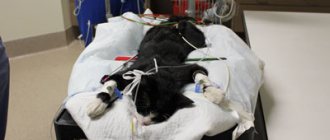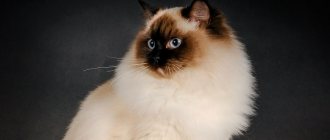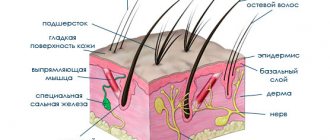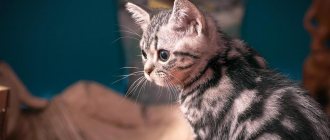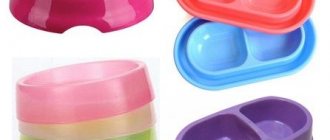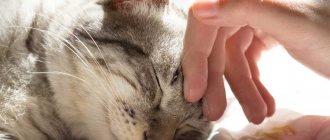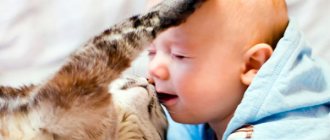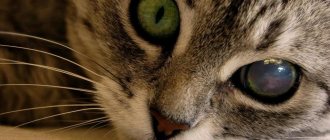Overweight in pets is a common problem that owners tend to underestimate. Against this background, dangerous diseases often develop, some of them irreversible. The sooner you think about how to help your cat lose weight, the greater its chances of a long and healthy life.
But in order to effectively combat the problem, it is important to understand its roots. Only by answering the question of why your cat is getting fat can you take the first step towards its recovery. We hope our article will help you with this.
The animal is overfed
Many owners simply pour dry food into a bowl and allow the pet to eat as much as it wants, adding more as it becomes empty. There is nothing wrong with this, because cats by their nature are not predisposed to overeating. But sometimes “the settings go wrong” and the animal loses its sense of proportion. The reasons for this may be different:
- experienced a period of hunger or malnutrition;
- excess carbohydrates in the diet (sudden surges in blood sugar spur appetite);
- food that is too tasty and difficult to stop eating;
- hormonal changes, taking certain medications.
Cats prone to obesity need to strictly ration the amount of food they eat. If you use ready-made complete food, there will be no difficulties with calculating the diet: all the necessary information is already on the packaging. On our foods it is presented in the form of a table, with a separate column for overweight cats.
When measuring food, you should use a branded cup or an accurate kitchen scale. Cat portions are very small, so even an error of 10–15 grams can interfere with weight loss. Also note that the indicated dosages are calculated per day, and not per feeding.
When feeding homemade food, the diet must be prepared individually. It is important to take into account not only the energy value, but also the distribution of macronutrients (proteins, fats, carbohydrates).
The cat is pampered with treats
Sometimes it’s not the food at all: it is given strictly according to the norms, but every time the cat visits the kitchen, she receives delicacies or treats from the owner’s table. If there are several household members and they eat at different times, the amount of food eaten by the animal cannot be controlled. Some foods that cats love have a fairly high energy value. Even a small piece of cheese, lard or sausage can be significant in the diet of an animal weighing 4–5 kg.
If you find it difficult to resist the attacks of a tailed beggar, simply keep him out of the kitchen during your own meals and snacks. Warn all family members that the cat is on a diet and should not receive anything other than the daily allowance of food. Otherwise, it will be difficult for your pet to lose weight.
The whole day is spent on the couch
In the wild, cats eat as much as they can and don’t get fat. The fact is that they are simply forced to move, getting food for themselves. In addition, they are constantly in a hostile environment, where they have to flee from larger predators. During the winter season, a lot of energy is spent on heating the body, which further increases the overall calorie expenditure.
Of course, in a city apartment it’s impossible to repeat all this, and it’s not necessary, but spending the whole day on the sofa is also not a good idea for a healthy cat. Encourage her to move with interactive toys and teases. Some cats love to play with rubber mice and chase laser pointers. Others become active in the presence of a companion. Look for what suits you.
Cognitive dysfunction
An older cat may have problems with its mental abilities. Behaviors that are considered simply "old age" are now widely accepted as a symptom of cognitive dysfunction. This form of frailty in cats begins to appear at age 10. Cats 15 years of age and older may experience acute symptoms.
As Topics in Companion Animal Medicine explains, feline cognitive dysfunction often occurs alongside other conditions. The most common symptoms are toilet problems and loud howling at night.
If your cat has cognitive dysfunction, she will live in constant confusion. The cat will forget basic tasks, including grooming. You will need to give your cat a helping hand. Take active care of your comb and brush.
Article Author: Richard Parker I'm Richard, I have experience in all matters related to feline health, behavior, grooming techniques and general pet care. Richard graduated with a degree in journalism in 2008. He is the proud owner of 5 adult cats (all adopted stray breeds), including an older cat who is now 20 years old.
Wrong diet
Above, we briefly touched on the topic of carbohydrates in a cat’s diet. Now let's look at this in more detail. The truth is that in their natural habitat, representatives of the cat family practically do not eat plant food, except perhaps along with the entrails of a herbivorous prey. By offering a cat food that is half or even more carbohydrates, we are going against its nature. This sooner or later results in disturbances in the normal functioning of the body, one of which is obesity.
The Acana and Orijen diets are biologically appropriate. This means that they are as close as possible to the diet of animals in nature: a lot of protein, a moderate amount of fat, a minimum of carbohydrates. For cats prone to obesity, we have a special food - Orijen Fit & Trim. Its energy value is slightly reduced in comparison with other products in the line and amounts to 371 kcal per 100 g. At the same time, the body receives 47% of calories from protein, 36% from fat, 16% from carbohydrates. The latter are represented by legumes, vegetables and unsweetened fruits, which do not cause sudden surges in blood sugar and, consequently, health problems.
How to find out the amount of carbohydrates in food? Usually this indicator is not indicated in the guaranteed analysis, however, knowing the amount of protein, fat and energy value of the product, you can calculate it yourself. It is important to remember that 1 gram of protein provides 4 kcal, 1 gram of carbohydrates - 4 kcal, and 1 g of fat - as much as 9 kcal. Sometimes it is enough to simply analyze the list of ingredients: sources of carbohydrates should not be in the first three to five positions.
My cat is obese: will diet help?
Against the background of increased physical activity, diet therapy is the only effective way to lose weight. No magical and safe diet pills have been invented - both for people and for cats. At the same time, unlike humans, cats are strictly contraindicated from starving, so the task becomes more difficult, but nevertheless it can be solved quite successfully.
It is best to consult a doctor and put the animal on a special veterinary diet, which is available in the range of some medicinal food brands. Such diets usually have the words Obesity or Overweight in their names.
They contain a reduced amount of fat (the main source of energy for carnivores), an average level of protein, but still sufficient to maintain muscle mass, and a large amount of fiber, which is not digested, contains no calories, but creates a feeling of satiety.
Also, such diets include a specially selected complex of vitamins and minerals, as well as additional substances that affect metabolism.
The animal has been spayed (neutered)
There is an opinion that weight problems begin after surgery to remove the gonads. But this does not mean that it is worth torturing the animal and tolerating its behavior during sexual hunting. You just need to take some preventive measures:
- feed the cat after sterilization strictly at the rate recommended by the food manufacturer;
- Weigh your pet weekly and record the result;
- if necessary, adjust the rate downwards.
Practice shows that with a normal diet and sufficient physical activity, most sterilized cats remain in good physical shape for many years. While with improper feeding and a sedentary lifestyle, even an animal with preserved reproductive function can quickly gain weight.
Castration of cats: indications for surgery
Castration is a simple surgical operation in which the gonads (testicles, testes) are removed from males. The main purpose of the operation is to deprive animals of reproductive function.
It is best to castrate cats after puberty, at the age of 8-10 months. Earlier castration can lead to serious complications and consequences, which often end in death. If you castrate a cat after the pet has already had contact with cats, the sexual instinct may remain, and the cat will continue to be interested in individuals of the opposite sex.
As a rule, veterinarians recommend castration for cats that are not of breeding value. Often cats are castrated after being removed from breeding, but as already noted, in this case castrated males may continue to show interest in cats.
Castration of cats is necessary:
- if the cat asks to go outside, constantly meows during the period of sexual heat;
- shows aggression during the rut;
- to prevent unwanted litters;
- leaves its marks in the house, apartment, entrance.
In some cases, the operation has medical indications (injuries of the scrotum, testes, cryptorchidism, congenital pathologies).
It is also worth noting that unneutered cats who do not have contact with cats can suffer from prostatitis. Such pets have an increased risk of developing urolithiasis.
Castrated animals live 65-70% longer than their non-castrated relatives. Viral and bacterial diseases and infections (herpes virus, chlamydia) are transmitted sexually.
In addition, if you constantly give males oral hormonal contraceptives, drugs to reduce sexual desire, or adjust behavior during the rut, the risk of developing tumors increases and hormonal levels are disrupted.
Neutered cats become calmer and, in rare cases, show aggression towards their relatives and family members.
The tendency to be overweight is determined by breed
We will not deny that some breeds are more prone to obesity than others. However, this is not a verdict, and everything is again in the hands of the owner. The cat gets fat not only because she is British, but also because she gets too much food. By eliminating the cause, you will get rid of the effect.
Please note that reversing obesity is much easier at the initial stage. If you see that your cat’s sides are rounded, and the spine and ribs are hard to feel under a layer of fat, you should reconsider its diet without waiting for it to turn into a ball.
Skin diseases
Cats can get fungal skin infections that damage their fur, such as ringworm and seborrhea. Fungal diseases are most common in outdoor cats. When a cat wanders outdoors, it may encounter other infected felines. These problems can cause cats to have oily fur.
© shutterstock
The pet is seriously ill
Rarely, there are situations when weight gain is caused by diseases that require immediate treatment. The specific cause here is difficult to determine only by external signs: consultation with a veterinarian and a full examination are necessary.
Fasting is contraindicated for cats! The daily norm can be reduced by a maximum of 10–20% and it is better to do this gradually, monitoring the pet, especially if it has any health problems. If, despite your best efforts, the weight does not decrease, it is wise to consult a veterinarian.

